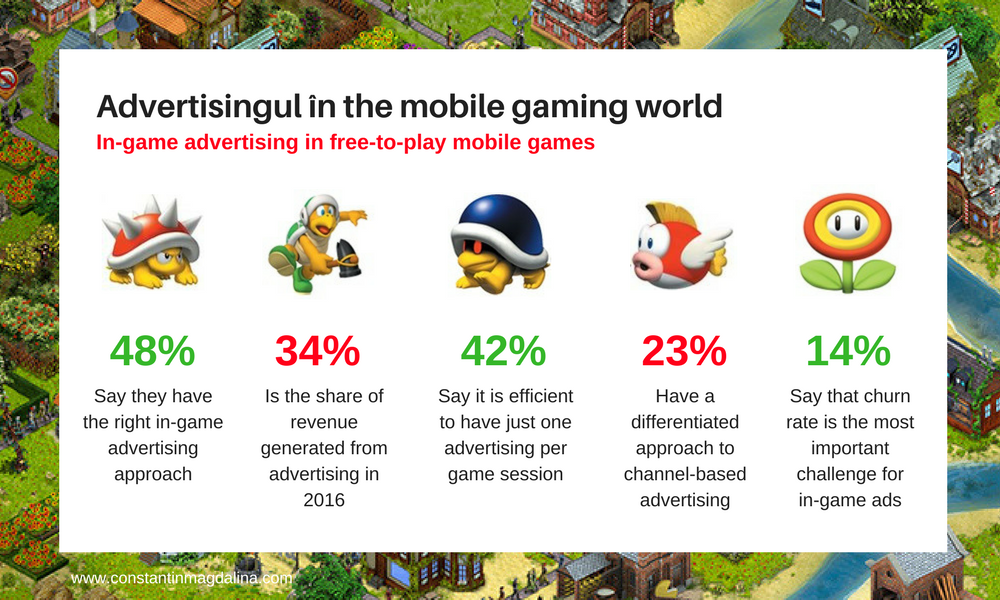"Doing business without advertising is like winking at someone in the dark. You know what you're doing, but nobody else does." That's a well-known saying in advertising. This saying is all the more relevant to the gaming industry. A good game without advertising is like trying to seduce an audience who does not even know that you exist. The similar case of an advertising that omits the propagation of message through the game environment. But let's turn on the light!
The mobile game industry is in full swing. According to Verto Analytics, for 57% of mobile device owners, mobile game play is the second most popular activity after using social media. Worldwide, this is the industry with an annual growth of 19%, a turnover of EUR 42 billion and 42% of the global gaming market.
The popularity of mobile games increases with the volume of smartphones and tablets sold. Through these mobile devices the contact with the consumer is quasi-permanent. The time allocated to their use is shared between basic features such as voice and message, social networks and online navigation. Thus, the behavior of playing mobile games is intermittent. Under these circumstances, the fight for gaining attention, testing a game, retention, and cash conversion of the gaming consumer is intense.
In summary, the best known 3 monetization models of mobile games are:
• Direct sale / premium, payable when downloading the game
• Freemium, basic features of free play and access to advanced features surcharge
• Free-to-play, hybrid monetization of ads and game functionality
Since free-to-play is the most commonly used monetization method, Delta DNA has made a global survey of in-game advertising in mobile games with free-to-play monetization (FTP).
The conclusions are as follows:
Advertising approaches
1. If in 2015, 54% of respondents said they had an optimal approach to advertising for gaming and 38% of revenue came from advertising, in 2016 only 48% of respondents thought they had the optimal approach and the advertising revenue share decreased to 34%.
2. The only in-game promotion that has grown from 36% to 42% is one ad or as little as possible per game session.
3. The distinct approach of advertising based on the promotion channel has seen a surprising drop from 36% to 23%, possibly due to difficulty or cost inefficiency.
Ad frequency
1. Surprisingly, only 14% of respondents consider churn rate as one of the biggest in-game advertising challenges, while 36% consider engagement and 29% fun as being the biggest challenges.
2. Contextualizing the answers can lead to the conclusion that the developers are not so worried about the number of ads themselves as to the ability to integrate them into the general experience of the game.
3. Whether they are rewarded or interstitial, if ads are not properly measured and applied, then they may be able to cannibalize in-app purchase conversions.
Ads type
1. The use of interstitials shows a decrease from 67% to 21%, as well as the rewarded video from 56% to 44%.
2. Banner ads are the only ones that record a more consistent increase from 39% to 50%.
3. A new entrance is the video ad that does not reward, but only exposes the user / consumer of games to a message relevant to him.
If the ad was initially seen as a relatively minor expansion of the game, the effect of this outlook on the conversion rate of the app purchases is very costly. The simple fact of reducing the number of ads only to avoid the risk of lowering retention has proved to be a false hypothesis. Research results show that game experience affects retention and not ad frequencies.
Integrating a promotional experience into the game can be harmful if it is not done well. If well integrated, it can lead to another level of experience and support retention. Therefore, advertising should not be treated as petty attachment to a game but as part of the mechanics of the game. The position of the ad on the screen, the value of the reward, the design, its availability in the game matter a lot. Thus, many of the winks of the advertising campaigns will have better chances to be spotted by those who are subject target.





























